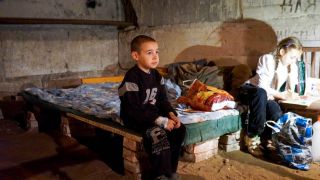“The situation in Kosovo is the way that whoever strikes the first will lose,” military expert at the Center for Strategic Trend Studies, the author of Yugoslav War book Oleg Valetsky said in an interview to EADaily.
The situation in Kosovo, a region seized from Serbia a decade ago, has heated up again. A group of Albanian fighters captured Director of the Serbian Government’s Kosovo and Metohija Office Marko Djuric in Kosovska Mitrovica on Mar 26. And the European Union Rule of Law Mission in Kosovo did nothing to help Djuric out.
From military point of view, the situation is not favorable for Serbia. According to Valetsky, in 1998, the Yugoslav Army had a Pristina corps in Kosovo. “It had two motorized and two mechanized brigades, two Mig-21 squadrons, a special operations unit (so-called Red Berets) and special police units – a total of 20,000-30,000 men. Nevertheless, according to the Terrorism of Albanian Extremists in Kosovo book by colonels Mijalkovski and Damjanov, in summer 1998, the Albanians controlled as much as 40% of Kosovo. So, one should not underestimate them,” Valetsky said.
In contrast, the so-called Kosovo Liberation Army had just 20,000-25,000 men possessing mostly lightweight weapons.
“As regards the current situation, the Albanians can use the Kosovo Security Force for capturing the north of Kosovo, where the Serbs have no organized forces. But they will not dare to do it as by doing it they will break the existing agreements and will give Serbia a ground for deploying troops and security forces in that area,” Valetsky said.
According to the expert, today the Serbian army is not much stronger than the Pristina corps was in 1998.
“In 1998, the Pristina corps had big problems with Albanian guerrillas. Today the Serbian Army has no more than 25,000 men and just one special purpose brigade. In case of a new operation in Kosovo, Serbia will be able to summon no more than 10,000 servicemen plus some 5,000 policemen. This is not enough for an efficient war,” Valetsky said.
“If you look at the map, you will see that should the Serbs enter the region, they will get in a narrow pass between the highland areas around Kosovska Mitrovica. If they try to go farther, they will get stuck in street fights in the south of that city,” Valetsky said.
“Despite general beliefs in Belgrade, the Albanians will not run away. The Serbs that fought them in 1998-1999 perfectly know this. So, any attack by Serbia may have very serious consequences. The Serbs will not be able to enter Kosovo through Presevo, Bujanovac and Medvedja as those areas are protected by the so-called Kumanovo Agreement, a document signed after the withdrawal of the Serbian security forces from Kosovo and prohibiting the Serbs from deploying armed forces there. If they do it, they will break one more international agreement,” Valetsky said.
He noted that the Albanians had lots of arms in hand. “In 2000-2001, they showed that their illegal units can effectively fight in others’ territories. They first fought in the south of Serbia (Presovo and Bujanovac) and then in FYR Macedonia. They did that despite the presence of KFOR. Should a new war start, the Serbs living in the north of Kosovo may find themselves in its epicenter,” Valetsky said.
As EADaily reported earlier, Serbian Foreign Minister Ivica Dacic said that Serbia was committed to a dialogue with the Kosovo Albanians, was not inclined to plot any military operations or provocations but would defend its own interests. Dacic advised mass media not to discuss the possibility of a new war but added that declaring refusal to use that option would be equal to inviting the separatists to attack the first.

 Vance is confident that Russia and Ukraine will eventually give up control over part of the territories
Vance is confident that Russia and Ukraine will eventually give up control over part of the territories "The Red Army did not liberate us": Sandu was forbidden to celebrate Victory Day in Chisinau
"The Red Army did not liberate us": Sandu was forbidden to celebrate Victory Day in Chisinau Following Rubio, the foreign ministers of France and Germany will not go to London
Following Rubio, the foreign ministers of France and Germany will not go to London Rubio changed his mind about going to London after Zelensky's refusal to recognize Crimea as Russian — NYT
Rubio changed his mind about going to London after Zelensky's refusal to recognize Crimea as Russian — NYT One Kellogg will be puffing up for the USA: Witkoff, following Rubio, refused to go to London
One Kellogg will be puffing up for the USA: Witkoff, following Rubio, refused to go to London There is nothing to talk about: Ukraine does not recognize Crimea as Russian — Zelensky
There is nothing to talk about: Ukraine does not recognize Crimea as Russian — Zelensky The explosions occurred in the Kirzhachsky district of the Vladimir region
The explosions occurred in the Kirzhachsky district of the Vladimir region